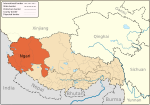Ngari Gunsa Airport
Ngari Gunsa Airport 阿里昆莎机场 ལྷ་ས་གོང་དཀར་རྫོང་ Ālǐ Kūnshā Jīchǎng | |||||||||||
|---|---|---|---|---|---|---|---|---|---|---|---|
| Summary | |||||||||||
| Airport type | Military/Public | ||||||||||
| Serves | Shiquanhe | ||||||||||
| Location | Ngari (Ali), Tibet | ||||||||||
| Elevation AMSL | 4,274 m / 14,022 ft | ||||||||||
| Coordinates | 32°06′31″N 80°03′10″E / 32.10861°N 80.05278°E | ||||||||||
| Map | |||||||||||
| Runways | |||||||||||
| |||||||||||
Source: [1] | |||||||||||
| Ngari Gunsa Airport | |||||||
|---|---|---|---|---|---|---|---|
| Simplified Chinese | 阿里昆莎机场 | ||||||
| |||||||
Ngari Gunsa Airport (IATA: NGQ, ICAO: ZUAL) is a dual-use military and civil airport serving the town of Shiquanhe in Ngari Prefecture, in the southwest of China's Tibet Autonomous Region near the Indian border. It started operations on 1 July 2010, becoming the fourth civil airport in Tibet after Lhasa, Nyingchi, and Qamdo airports.[2]
Situated at 4,274 m (14,022 ft) above sea level, Gunsa Airport is the fourth highest airport in the world after Daocheng Yading Airport, Qamdo Bamda Airport, and Kangding Airport.[3][4] Gunsa airport has a 4,500-meter runway. It is expected to handle 120,000 passengers by 2020. Construction began in May 2007 and cost an estimated 1.65 billion yuan (241.22 million U.S. dollars).[2]
As Shiquanhe (Ali) is only a one-day bus drive (about 330 km) from the settlement of Darchen situated just north of Lake Manasarovar, facing Mount Kailash,[5] it is expected to benefit pilgrims to these two sites, which are considered sacred by Hindus,[6] Buddhists, Bonpa and Jains.[7][8] With the opening of Shigatse Peace Airport in October 2010, the five airports, coupled with the Qinghai–Tibet railway and a network of roads, are expected to increase tourism to scenic and holy sites in Tibet.[6]
Airlines and destinations
| Airlines | Destinations |
|---|---|
| China Eastern Airlines | Kashgar, Xi'an |
| Tibet Airlines | Lhasa |
| Lucky Air | Kashgar, Urumqi |
See also
Footnotes
- ^ 阿里昆莎机场 Archived 2012-04-04 at the Wayback Machine
- ^ a b Tibet's fourth civil airport opens Archived 2010-12-14 at the Wayback Machine
- ^ The world’s third highest airport opens with milestone Airbus A319 flight Archived 2014-12-04 at the Wayback Machine
- ^ 西藏阿里昆莎机场迎来首航 为世界海拔第三高
- ^ Mayhew and Kohn (2005), p. 209.
- ^ a b "Pilgrims to benefit from new Tibet Airport near Mt Kailash."
- ^ Albinia (2008), p. 288,
- ^ Gyurme (199), p. 36.
References
- Albinia, Alice. (2008) Empires of the Indus: The Story of a River. First American Edition (2010) W. W. Norton & Company, New York. ISBN 978-0-393-33860-7.
- Dorje, Gyurme. (2009) Tibet Handbook. Footprint Handbooks, Bath, England. ISBN 978-1-906098-32-2.
- Mayhew, Bradley and Kohn, Michael. (2005) Tibet. 6th Edition. ISBN 1-74059-523-8.


